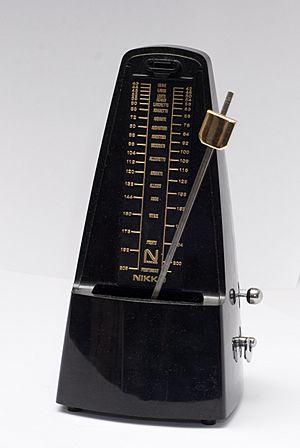Metronome facts for kids
A metronome is a helpful tool that musicians use to play their instruments at a steady speed. It's like a musical clock that ticks or beeps to keep time! Composers also use metronomes to tell performers exactly how fast their music should be played.
Contents
How Metronomes Work
There are two main types of metronomes: traditional (mechanical) and electronic.
Mechanical Metronomes
Older, traditional metronomes work using clockwork, similar to how some old clocks operate.
- They have a swinging arm called a pendulum.
- The pendulum makes a loud ticking sound as it swings back and forth.
- You need to wind them up every few minutes to keep them going.
- There's a small weight on the pendulum that you can slide up or down.
- Moving this weight changes how fast or slow the metronome ticks.
- Numbers on the metronome show how many ticks it makes in one minute. For example, if you set it to 60, it will tick 60 times in a minute, which is once every second.
- The speeds usually range from 40 (very slow) to 208 (very fast) ticks per minute.
Electronic Metronomes
Today, many musicians use electronic metronomes.
- These are very accurate and don't need to be wound up.
- They often have extra features, like a tone to help you tune your instrument.
- Some electronic metronomes are very small, even as tiny as a credit card!
Who Invented the Metronome?
The metronome was first invented by Dietrich Nikolaus Winkel in Amsterdam in 1812. However, a man named Johann Maelzel later copied Winkel’s ideas and made some improvements. Maelzel created a smaller, portable metronome and received a patent for it in 1816.
How Composers Use Metronomes
The invention of the metronome made it possible for composers to show musicians the exact speed they wanted their music to be played.
- For example, a composer might write "Crotchet = 76" at the top of a piece of music.
- A crotchet is also known as a quarter note.
- This means the metronome should be set to 76 ticks per minute.
- The metronome will then tick at the perfect speed for that song.
- Sometimes, composers write "MM76." The "MM" stands for "Maelzel's Metronome," honoring Johann Maelzel.
- The famous composer Ludwig van Beethoven was one of the first to use metronome markings in his music.
- However, some of his speed markings were very fast, which makes people wonder if he made mistakes or if his metronome wasn't working perfectly!
Other pages
Images for kids
See also
 In Spanish: Metrónomo para niños
In Spanish: Metrónomo para niños




